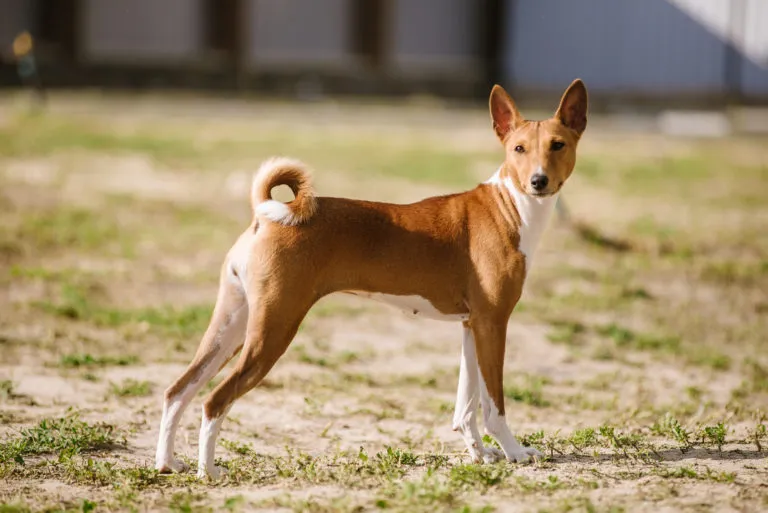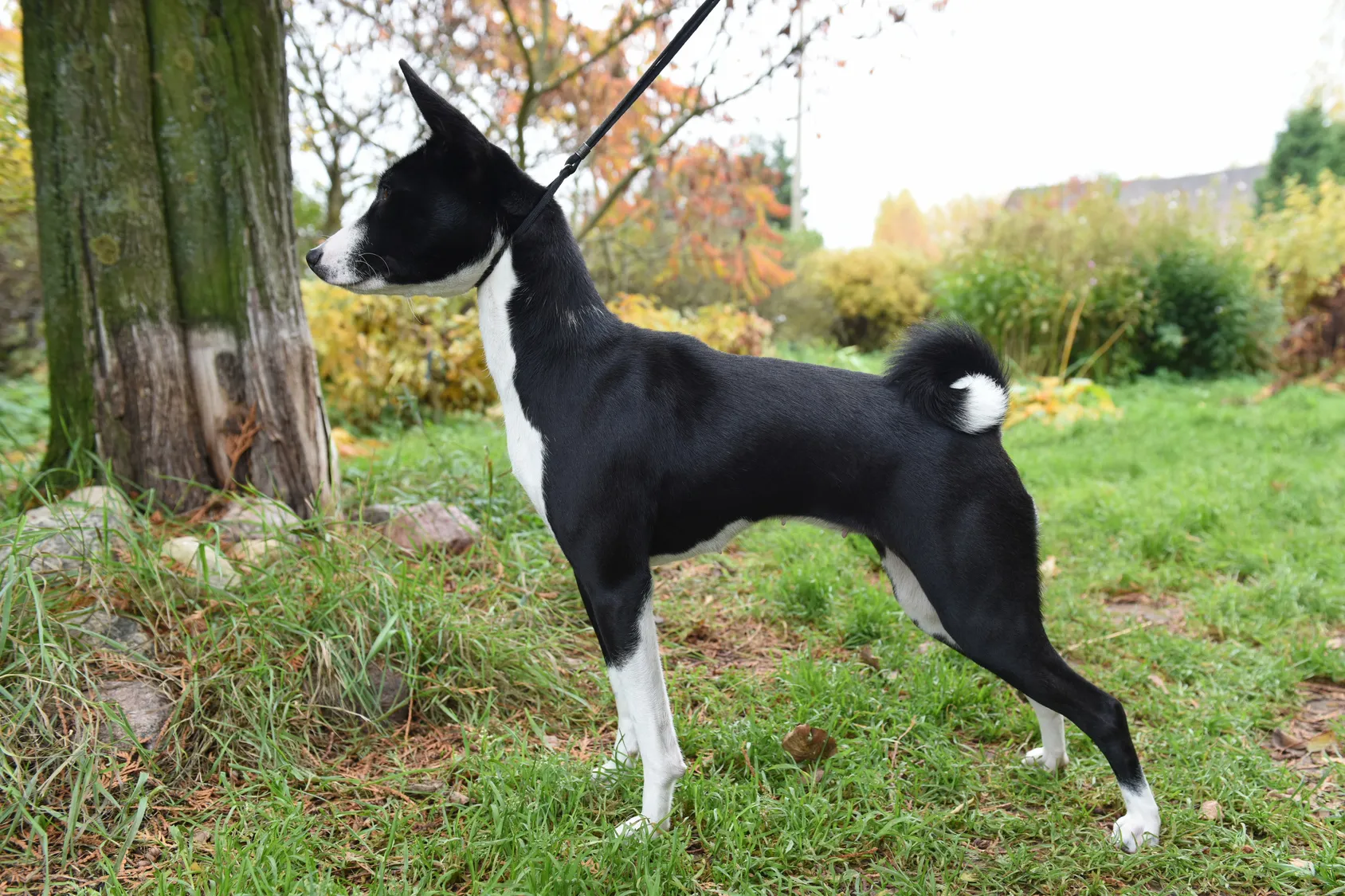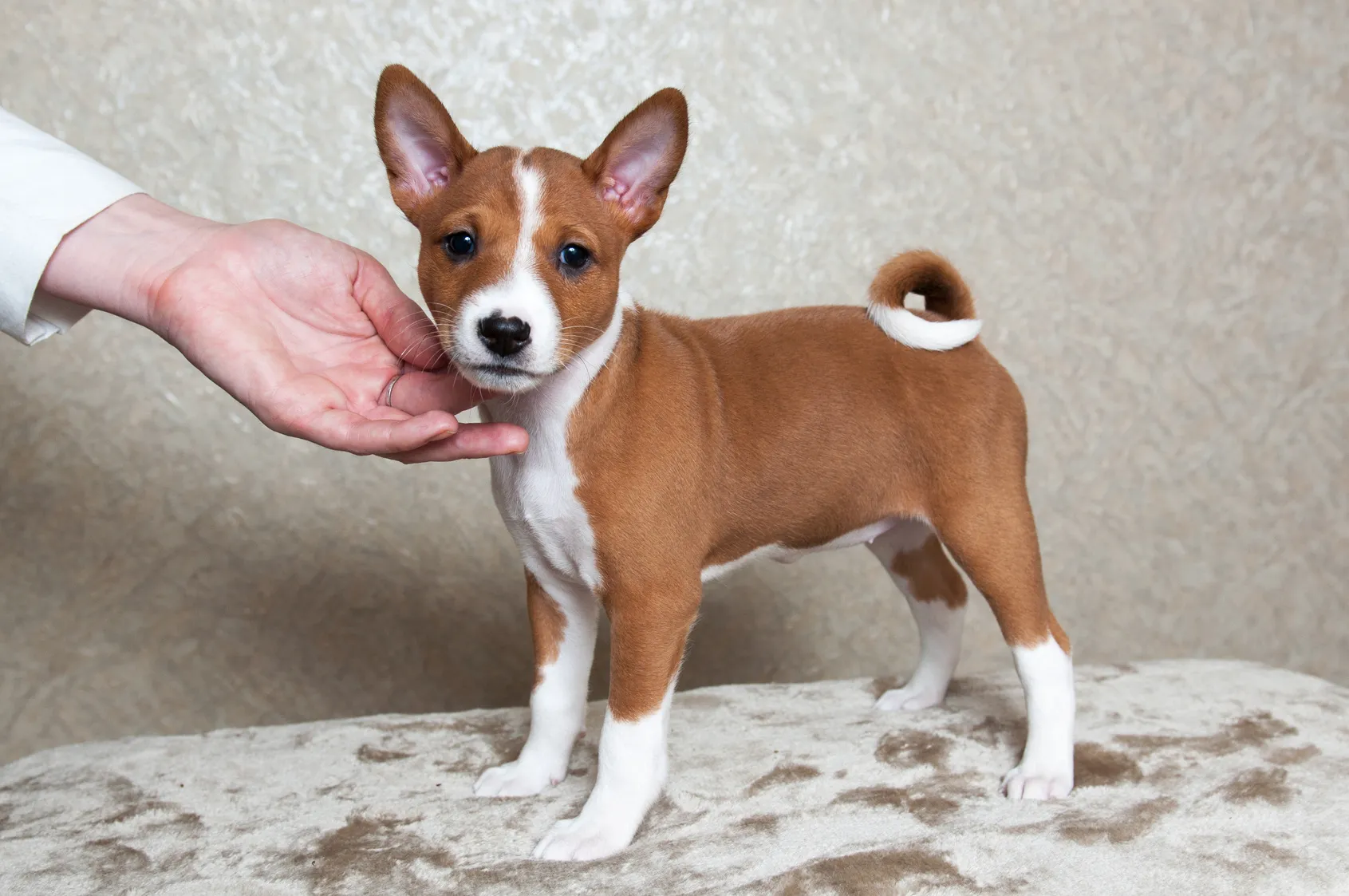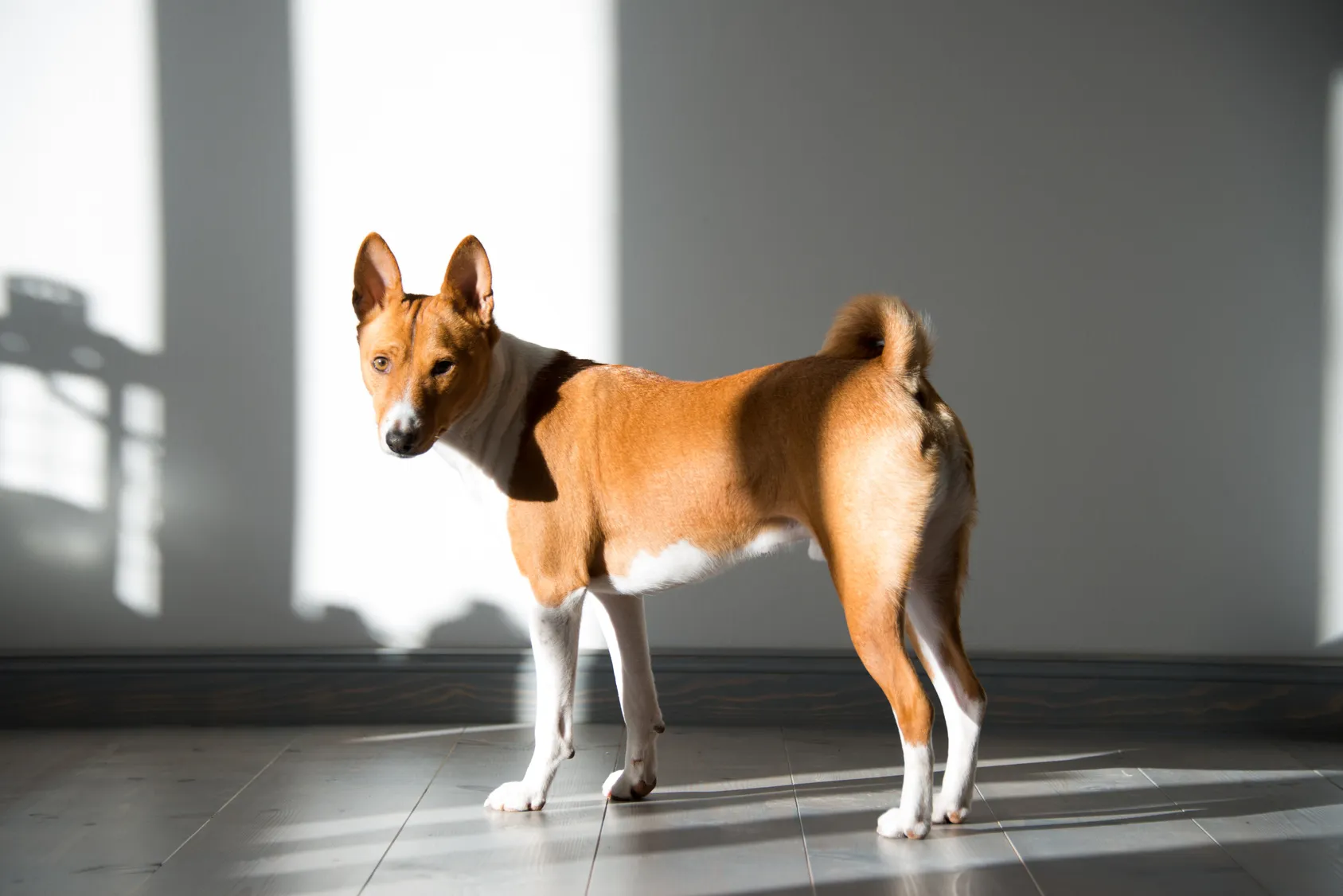Medium Size Poodle
The Basenji doesn't just stand out thanks to its noble appearance, but also leaves a lasting impression with its cheerful nature. It is a dog for experienced dog owners who want their companion to know their own mind.

© sushytska / stock.adobe.com
The Basenji comes across as very noble due to the combination of its trim physique with large upright ears and a proud gaze. The pronounced forehead wrinkles further accentuate the unusual look. The throat is gently curved and the tail curls back onto the spine. With its elegant, square-shaped physique, the Basenji reaches a maximum height of 43cm and weights between 9 and 12kg. The fur is elegant, thick and shiny. The breed is found in black and white, red and white, black, tan, white with tan markings, as well as tabby blotched, where the fur is made up of black stripes on a red base colour.
Stone-age images and ancient Egyptian tombs bore witness to the existence of this type of dog, which has survived over many centuries: the Basenji is a very old and primitive dog breed. The assumption is that it is a direct descendant of the ancient Egyptian Tesem – this is the name canine experts give to the type of dog passed down to us through Egyptian depictions from the fourth millennium before Christ. The Basenji is from central Africa, where it lived with village communities, though it was neither bred in a targeted manner nor formed particularly close bonds. On the contrary, Basenjis lived as rat catchers. Humans often also followed hunting Basenjis in order to benefit from their prey themselves. These dogs were even slaughtered in times of famine. “Basenji” translates as something like “wild little outback animal”. Some Basenjis travelled to Europe with Africa researchers at the end of the 19th century, but targeted breeding only commenced around 1935 in Britain. Although these dogs originally come from Africa, nowadays Britain is the country of patronage. The breed gradually spread across the rest of Europe from Britain. In Germany, for instance, the Basenji has been very popular from the 1970s onwards.
Character : imp with feline character
Due to living side-by-side with humans for many millenniums, the Basenji has remained a primitive dog at heart and is characterised by its strong independent streak. It is friendly towards those it trusts, smart and adventurous, but it is not willing to subordinate. You can teach your Basenji some canine basics with a bit of patience, but this breed usually shows no great will to please. This is due to the fact that it only had a loose connection to humans over the millenniums rather than a strong bond. Basenjis bark in a very monosyllabic manner without any form of melody, although they do make typical sounds that resemble yodelling as well as barking. They are very attentive outdoors, sometimes with certain anxious tendencies. They have a strong hunting instinct. If your Basenji encounters dominant dogs or others from the same breed when out and about, it can feel very uncomfortable. Otherwise, this breed likes to play with its counterparts and soon makes friends, as long as it was socialised in the right way.

Expertise, plenty of patience and good humour are required if you wish to train a Basenji, because these dogs basically do what they want. However, with a strong bond, lots of time and positive reinforcement, you can teach them basic obedience. Don’t set any overly ambitious targets and place great value on your relationship with your dog, because this is the basis for training these stubborn little canines. They need clear structure in the form of consistent rules and a fixed rank in the hierarchy. Never put the Basenji under pressure, because this tends to make it completely closed off and training comes to a standstill. If your Basenji is a family dog, it’s important that all members of the family stick to the rules consistently and don’t make any exceptions. Factor in generous and targeted relaxation periods during training. It can be problematic to retrieve your Basenji outdoors, because once it gets going, it doesn’t stop – especially not if it has spotted potential prey. Attending a dog school is certainly helpful, but look for a trainer who has experience with stubborn dogs, accepts the autonomy of the breed and steers this in the right direction with positive reinforcement. Comprehensive socialisation and rearing are important from an early age so that the Basenji can cope well with other dogs and people.
Although the breed is robust in principle, it can have a genetic disposition to certain ailments in some lines. Choosing a puppy from a breeder who operates with their head and heart is therefore essential to ensure the dog is in good health. Basenjis can have a tendency to develop renal diseases – what is known as Fanconi syndrome – eye problems in the form of retinal atrophies and hernia. Originating from Africa, these dogs do not cope well with the cold – make sure that they don’t suffer too much in winter. A dog coat can be a very sensible accessory for Basenjis. Females only enter heat once a year. If they get exercise and are fed in a species-appropriate manner, Basenjis largely remain playful and full of life into old age. These agile dogs can live to the age of 15 years and above.
The contents of the Basenji’s food bowl being correct is part of optimal healthcare provision. Thus, make sure that your Basenji has a high-quality dog food with a high quantity of meat and no grain. This applies for both wet and dry food. These slender dogs quickly gain weight if they consume too many calories and are good feed converters. It is essential that you keep an eye on your companion’s physique or weigh it once a month in order to sensibly tackle the threat of obesity. If this comes to pass, reduce portions and avoid treats – unless these are part of the calculated daily intake. For instance, you can use a high-quality dry food as a treat that the Basenji has to work for. However, you should get your dog used to alternatives to being rewarded with treats from an early age – how about playing with or stroking it for a short period of time? Both are fun without encouraging weight gain. Dried chew products like cattle ears or chewing bones satisfy your dog’s urge to chew. Always makes sure that fresh drinking water is freely available to your dog.
 © zanna_ / stock.adobe.com
© zanna_ / stock.adobe.com
Both the character and cleanliness of these dogs bring to mind cats for some owners: Basenjis are markedly clean, preen themselves regularly and would not wallow in mud in most cases. They hardly have any typical “dog odour” and the short fur requires very little grooming. Nevertheless, you should comb the fur every few days or groom it with a massage glove – this strengthens your connection with your dog and removes loose hairs at the same time. In any case, your dog practically sheds relatively little hair in your home. On this occasion, check your Basenji’s ears and clean them if necessary with a special ear cleanser for dogs. Keep an eye on your companion’s claws too and trim them if required with clippers. Some dog owners get their puppies accustomed to dog toothpaste and a toothbrush – a somewhat unusual but highly effective way of preventing tartar. If regular teeth cleaning is a possibility for you and your dog, do research early on and patiently practise this grooming ritual – a shortened version too – when your dog is still a puppy.
These breed loves plenty of exercise, but it must remain on the lead in most cases, since the majority of Basenjis do not return reliably upon command. However, there are of course exceptions – particularly if the ancestors were easy to retrieve and you as the owner focus on relevant training from the puppy phase. But you can still discover plenty together on the lead – ideally a flexi or drag lead. Always bear in mind that a quick 10-minute walk doesn’t wear our a Basenji whatsoever – you should be on the move together for around two hours each day. Perhaps you need an alternative indoor schedule on some days, because this breed does not like the rain one bit – many Basenjis prefer to retreat to within the warmth and dryness of the four walls of their home. This can also affect dogs that otherwise love going swimming. If it starts to rain, fun in the water is over! As well, Basenjis make excellent companions for joggers or inline skaters – provided that they are of adult age and have undergone suitable training. Many dogs from this breed also enjoy tricks, hide and seek or ball games. Hunting simulations like coursing or running around a dog track after a mechanical hare or other artificial prey. Obedience tests are not a good match for the independent Basenji.
Basenjis aren’t the right dogs for everyone, since they have high demands regarding their environment. If you wish to have a cheerful, free-spirited dog as your housemate, a Basenji could be the right choice for you. However, this primitive breed needs an experienced owner with a sense of humour, who can teach it basic obedience but turn a blind eye at the right moments to allow it to maintain its characteristic stubbornness. It can be kept in a city apartment, but then needs plenty of exercise and activity for intellectual stimulation, meaning that it will take up a lot of your time. If your Basenji has access to a fenced garden, it will have lots of fun exploring and guarding this area. Make sure though that it can’t jump over the fence and check the garden regularly for potential areas for break-out attempts, such as holes close to the fence.
The Basenji fits in well with a pack – in fact, it doesn’t like to be alone. These friendly dogs generally cope well with children from school age, who have learnt the basic rules of behaviour towards animals and have more coordinated movement than younger children. Although it is also possible for the Basenji to live with younger children, you should not leave them unsupervised. Check too that there are no allergy sufferers in your family.
Before the dog enters your home, make care arrangements for when you fall ill or go on holiday. Some holiday destinations are also well suited to taking a Basenji with you – for instance, if you are planning a hiking holiday. Many hotels nowadays happily accept well-trained dogs accompanying guests. It’s even better if a known family member can take care of your Basenji in a familiar environment. Owning a Basenji is a big responsibility for around 15 years – it is definitely wise to estimate recurring costs beforehand.

The Basenji definitely isn’t a commonly spotted breed, but there are some breeders spread across Europe who have devoted themselves to breeding young Basenjis. In Germany, for instance, several dozen Basenjis are born each year. With some luck, you will find one in your region – research Basenji breeders online and their current litters. It’s important that you only purchase a puppy from a breeder if they are affiliated with a canine association. This is the minimum requirement for a serious breed, which should also be formed with plenty of expertise and following relevant health examinations. Visit your potential new housemate in its home, where you can also get an impression of the parent animals. The breeder will be happy to inform you of their objectives regarding character, type and health, because a responsible breeding process is much more than simply pairing two dogs of the same breed. Your dog is allowed to move in with you at the age of eight weeks at the earliest.
If you prefer to opt for an older Basenji, you could get really lucky and find a pedigree Basenji after some searching. Don’t give up straight away if your local animal home doesn’t have any suitable dogs, but pay it a visit calmly first – after all, perhaps there is another just as interesting dog waiting for a new home that suddenly wins you over. Otherwise, search online and ideally rely on animal welfare organisations. Find out in advance about your potential new companion’s life so far, because what it has experienced in the past will determine how challenging it is to train.
We wish you lots of joy with your cheerful Basenji.
Also read our article on Getting puppies settled in: basic equipment & tips!
Fans of the Bearded Collie agree that those who aren't familiar with this dog breed simply have to get acquainted with it. And those who have experienced how a Bearded Collie bolts across meadows with its flowing fur, how it rolls around full of energy and joy and how it attentively and observantly takes into account its owners wishes become simply addicted to this original dog breed and its unique charm.
The Goldendoodle isn't a breed, but a pairing between Golden Retrievers and Medium or Standard Poodles. Marketed as a low-maintenance dog for allergy sufferers, this hybrid is enjoying increasing popularity amongst dog lovers, similar to the Labradoodle.